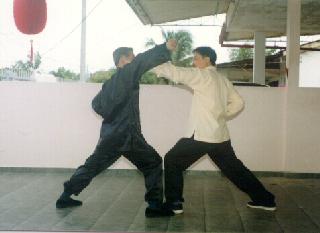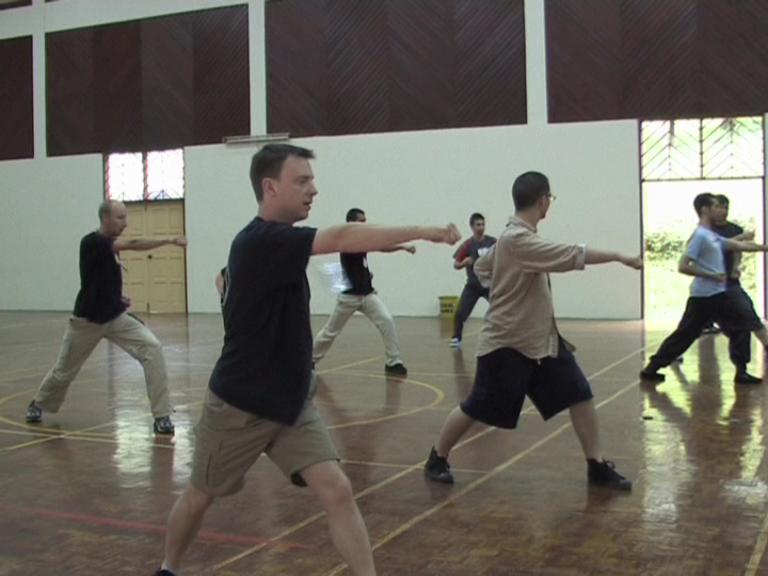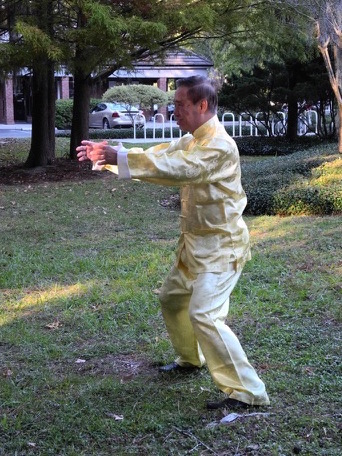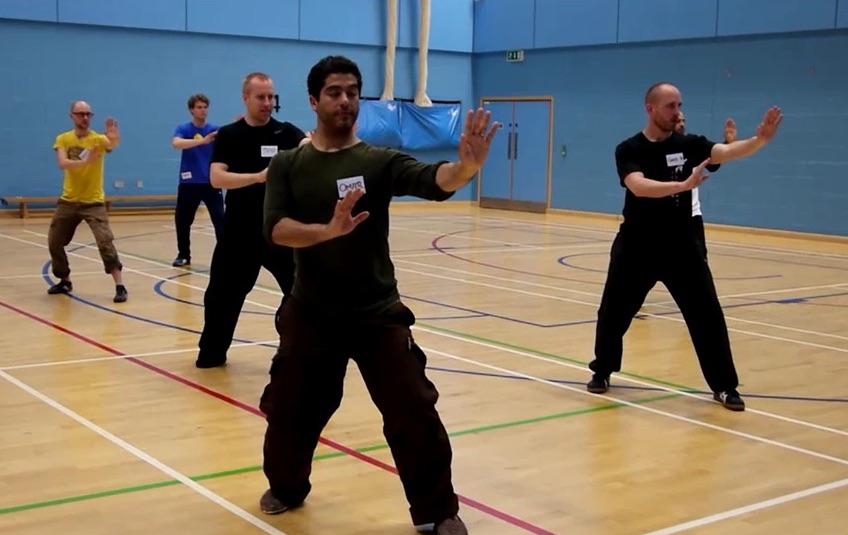SELECTION OF QUESTIONS AND ANSWERS
MAY 2016 PART 1

The principle of straight against circular can be seen in the application of Immortal Emerges from Cave against Hang a Golden Star
Question 1
Can you please elaborate with short examples or techniques on circular against straight, and vice versa?
— Sifu Leonard Lackinger, Austria
Editorial Note: These questions from Sifu Leanard are continued from the previous issue, April 2016 Part 3.
Answer
The principle of circular against straight is frequently used in Taijiquan. Warding off an opponent's thrust punch with Immortal Waves Sleeves is applying this principle of circular against straight. The circular movement of Immortal Waves Sleeves minimize the straight forceful punch.
In Taijiquan the principle of circular against straight is often implemented by waist rotation. When a strong opponent pushes at you, you rotate your waist to push him aside.
Circular against straight is not just for defence; it may be used in attack. When you throw a big opponent onto the ground using Carry Tiger Back to Mountain, for example, you apply circular against straight by rotating your waist after off-balancing him.
The principle of straight against circular is often used in Shaolin Kungfu. When an opponent throws a circular horn punch at you, you intercept his punch with Immortal Emerges from Cave, breaking his forearm or elbow.
As a straight movement is faster than a circular movement, the prinicple of straight against circular may be used to strike an opponent as he begins to use a circular movement to attack you. When an opponent attempts a circular sweeping kick at you, for example, you can step forward and kick him with a frontal thrust kick. You kick will fell him when his kick is just half way through its movement.
Straight against circular can also be used in defence. When an opponent tries to fell you with Carry Tiger Back to Mountain in Taijiquan, or Fell Tree with Roots in Shaolin Kungfu, you can move your front foot straight forward to neutralize his leverage advantage.
Question 2
Level 5 of Shaolin Kung Fu also includes breath co-ordination. I already employed it in the lower levels after teaching Lohan Asks the Way. Should I wait until level 5 for future students/groups?
Answer
It would be advisable to wait till Level 5 to teach them, as there are many other areas to cover at lower levels. However, if you have taught students breath control before they have attained Level 5, it is alright. It is a bonus for the students.

Black Tiger Steals Heart is an excellent pattern to practice exploding force
Question 3
What would be a good progression in breath control and at which level should each step be taught?
Answer
A good progression in teaching a pattern, a sequence or a set is as follows:
- Routine.
- Form.
- Force.
- Flow.
Breath control is under the section on force or flow.
This was the progression I initially used in my Intensive Shaolin Kungfu Course in teaching Lohan Asks the Way, and it was so successful that now I use this progression to teach any pattern, sequence or set in any course.
This progression of routine --> form --> force --> flow constitutes the force method. If I use the flow method, the progression will be routine --> form --> flow --> force.
First I teach the routine of performing a pattern, a sequence or a set. If it is a single pattern, students must get all the parts of the movement in a correct order, like differentiating yin-yang, weight on the back leg, rotating the waist, and completing in the hand. Initiately they learn the pattern in parts, then they learn it in one smooth flow.
If it is a sequence or a set, students must get the order of the patterns forming the sequence or the set correct.
Next, I teach picture-perfect form. One main reason why some students do not have picture-perfect form is because they have not spent sufficient time on stance training. When ones stances are correct, it is not difficult to have picture-perfect form.
A good guideline to picture-perfect form is attaining the three external harmonies of feet, body and hands.
Having attained picture-perfect form, the next step is to be forceful in the performance of the pattern, sequence or set. I teach students how to explode force, or fa-jing. Black Tiger Steals Heart is an excellent pattern for this purpose. The movement should start from the back leg, the force issues from the dan tian, and the movement completes at the punch which should spiral out.
When students have acquired the skills of fa-jing from Black Tiger Steals Heart, they can apply the same skills to other patterns, including patterns that are normally used for defence.
The final stage in this progress is flow. If it is a pattern, the whole pattern should be performed in one smooth flow, without neglecting force and picture-perfect form. If it is a sequence or a set, the various patterns in the sequence, or the various sequences in the set, should be performed in one smooth flow.
The smooth flow should be executed in one breath, known in Chinese as "yi qi ke cheng", or word-for-word "one-energy-able-accomplished". The structure of the breath is usually "in-follow-follow-follow-explode-swallow".
If there are more than one strike in the sequence, there will be more than one explode-mode in the breath. Hence, a sequence usually ends with a strike, where a practitioner uses the explode-mode of breathing as he explodes force, followed by gently swallowing.
If I use the flow-method in my teaching, the sections "force" and "flow" are reverse, with flow coming before force.
In the flow section, students perform various parts of a pattern, or various patterns of a sequence, in a smooth flow. First, the physical movements flow smoothly. Then the vital energy flows smoothly. They should also perform the flow of form and energy with mental focus. Hence, the students attained the three internal harmonies of elegance, energy and mind. Together with the three external harmonies, they attain the six harmonies.
As their form flows, the students gently use their mind to have more and more energy flow. This brings them to the final stage of force. Hence, they perform the routine correctly with picture-perfect form in a smooth flow with much force.
This progression of routine-form-force-flow in the force method, or routine-form-flow-force in the flow method, is excellent, but it should be used as a guideline, which means modifications or variations should be made to meet expedient needs.
Question 4
Regarding the Three Circle Stance, what is the ideal or established starting movement?
- Moving the hands forward from the Lifting Sun and Moon position
- Just lifting the arms into the position (similar to Lifting Water, but with Holding Cosmos arm position)
What is the ideal or established closing movement?
- Collecting chi from the Cosmos to the Dantian (I find this version more holistic)
- Just lowering the hands (I find this version more powerful in the arms)
Answer
We need not be too rigid in its starting movement and closing movement as long as the stance is performed correctly. Remember that kungfu is alive. Any one of the movements you have mentioned, or other suitable movements, can be used for the particular situation.
In my Intensive Taijiquan Course, which can act as a model for instructors teaching their students, I normally start the Three-Circle Stance by moving into the right footwork position being relaxed and upright and without worrying about the hands. When students have achieved this, they raise their hands to hold the "Cosmos" in the Three-Circle Stance, paying attention that their elbows are lower than their wrists, and their wrists are lower than their shoulders.
In completing the Three-Circle Stance, students just drop their hands as they move back to their original starting position. Lifting their hands may cause their energy to rise up, instead of focusing at their dan tian.

Three-Circle Stance
Question 5
Some schools consider "Hsin Tao" as the fore-runner of Chi Kung and as was taught by the Venerable Bodhidharma. Do you know anything about this art?
Answer
Do you mean "the way of immortals" when you mentioned "hsin tao"? If so, "hsin tao" is Taoist cultivation, and was not taught by the Venerable Bodhidharma, who taught Buddhist cultivation.
If we take "hsin tao" as spiritual cultivation, not necessarily limited to Taoist practitioners, I still do not think it was the fore-runner of chi kung, and also it was not what Bodhidharma taught.
The earliest archaeological evidence on chi kung, a jade pedant arcanely describing the Small Universe, dated back to BCE 380, which was about 10 centuries before Bodhidahrma arrived at the Shaolin Monastery in 527 CE.
Chi kung was discovered by nameless people even much earlier before an advanced art like Small Universe was established, when they found out that by managing their energy through their breathing they could be more effective when performing daily tasks. Hence, the earliest chi kung dealt with better daily performance, health and vitality, and not with spirituality, which was the concern of "hsin tao".
Bodhidharma taught the Shaolin monks to attain Enlightenment, not to become immortals. Attaining Enlightenment, or merging with the Cosmos where there is no differentiation, was transcendental, whereas becoming an immortal was still in the phenomenal realm.
Nevertheless, "hsin tao" or the way of the immortals, could be (or could not be) the fore-runner of "tao yin" exercises, which constitute a major part of chi kung. I have translated "tao yin" exercises as dynamic patterns. Some examples of dynamic patterns are Lifting the Sky, Pushing Mountain, and Bear Walk.
Please take note that "tao yin" is transcribed as "dao yin" in Romanized Chinese. The Romanized Chinese "d" is pronounced like the English "t". Hence, "dao yin" should be pronounced as /tao yin/ and not as /dao yin/, just as "Dao" should be pronounced as /tao/ and not as /dao/.
Question 6
Many students aim to have a perfect body. Is this a good or a bad approach?
— Sifu Andrea Zilo, Switzerland
Answer
This is a good approach.
There are two schools of thoughts on spiritual cultivation.
One school believes that the body is not important. The body can be smelly and dirty; what is important is to cultivate the spirit.
The other school believes that the spirit is also the most important, but the body is also important, especially when the spirit is housed in the body.
Bodhidharma believed in the second school. Hence, when he found the Shaolin monks weak and sickly he taught them Eighteen Lohan Hands and Sinew Metamorphosis to strengthen them physically, emotionally, mentally and spiritual so that why can better practice Zen meditation to cultivate their spirit.
Perfecting our body is also in line with chi kung philosophy and kungfu philosophy.
Chi kung is triple-cultivation, i.e. cultivation of the body, energy and the spirit. Progress is also in this order. In other words, as a result of his chi kung training, a practitioner first perfect his body, then his energy and eventually his spirit. If he is sick, for example, the benefits from his training will first overcome his illness, i.e. perfecting the body, instead of doing other things like giving him more stamina in his games or more focus in solving problems. The progression, nevertheless, is cyclic, not linear.
While mediocre kungfu is about fighting, good kungfu is also triple-cultivation. The progression is also in the order of body, energy and spirit. In other words, before a practitioner of good kungfu talks about effective combat, vitality for peak performance, and attaining spirituality, he should first of all be healthy, i.e. perfecting his body

Santi Stance
Question 7
In Xingyiquan, can we develop internal force by just practicing the Santi Stance?
— Miyoko, Japan
Answer
Yes, we can develop internal force by just practicing the Santi Stance -- without practicing other stances and other force training method.
In fact, the Santi Stance is excellent for developing the type of internal force required by Xingyiquan. Initially I was surprised why the Santi Stance, which is well know for developing internal force in Xingyiquan, is asymmetrical, unlike the Horse-riding Stance and the Three-Circle Stance which are primary means to develop internal force in Shaolin Kungfu and Taijqiquan, and which are symmetrical.
This puzzling question was accidentally answered when I prepared to teach Xingyiuqna at the UK Summer Camp in 2013. In the preparation I read up a lot of Xingyiquan classics. It was mentioned in one of the classics that the Correspondence Mode and the Expansion Mode were used in practicing the Santi Stance. although the explanation was brief, as most explanations in classics were, I could understand the underlying philosophy straightaway.
When I employed the Correspondence Mode and the Expansion Mode at the Xingyiquan course at the UK Summer Camp, course participants were amazed at the tremendous amount of force generated, and this force was particularly useful for Xingyiquan.
Not many Xingyiquan practitioners know about the Correspondence Mode and the Expansion Mode of the Santi Stance. Indeed not many people have heard of these two terms.
Will Xinyiquan practitioners who have no knowledge of the Correspondence Mode and the Expansion Mode be able to develop internal force by just practicing the Santi Stance? Yes, they will, but they will be far less effective had they also employed the Correspondence Mode and the Expansion Mode.
On the other hand, even if they employ the Correspondence Mode and the Expansion Mode in their Santi Stance training, Xingyiquan practitioners will get better result if they first spend some time on the Horse Riding Stance before attempting the Santi Stance. (In the Xingyiquan course at the UK Summer Camp, we did not spend much time on the Horse-Riding Stance prior to the Santi Stance, because all the course participants had previously practiced the Horse-Riding Stance well.)
Training the Horse-Riding Stance first will develop foundation at their dan tian. This will not only speed up their training of the Santi Stance later on, but also enhance both their solidness and agility as well as give them good health and vitality.
Many people may be surprised how stance training can enhance both solidness and agility, as these terms are ordinarily contradictory. But Shaolin Wahnam students would know. If you don't, please ask your sifu.
Question 8
When I did the Monkey Play just now, I felt my stomach giving off chi. Was this because of clearing my blockage or because of chi being generated?
— Antonetta, Italy
Answer
It was because of clearing your blockage.
But you did generate extra chi. Your blockage was already present before you practiced the Monkey Play. Why didn't you clear the blockage earlier? It was because you didn't have sufficient chi to do so.
Your Monkey Play generated more chi, and the nature of the practice directed your extra chi to your stomach. The extra chi, together with the exercise of the Monkey Play, enabled you to clear your blockage.
If you have any questions, please e-mail them to Grandmaster Wong via his Secretary at stating your name, country and e-mail address.
LINKS
Selected Reading
- Skills and Techniques of Kungfu and Chi Kung
- Combat Application of the Shaolin Flower Set
- How to Plan a Training Schedule
- The Five Basic Kicks
- Counters against Judo, Aikido and Jujitsu Attacks
